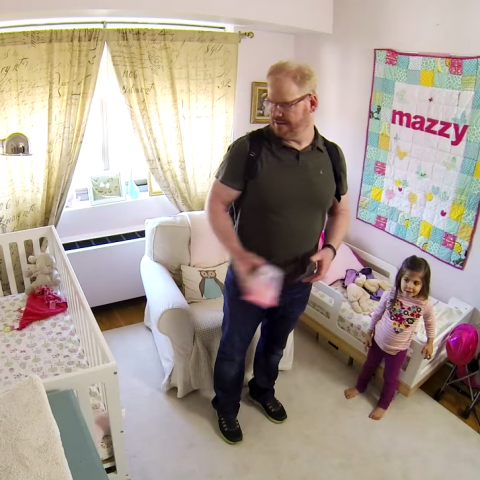Welcome to my new series— Big Kid Bedtime Problems! Certified sleep consultant Hadley Seward is going to help us sort through our issues. She will be addressing some of the specific sleep problems I talked about having with Mazzy and Harlow in a future post. Today, she’s kicking off the series with general guidelines for parents of toddlers and up who find their nighttime routines spiraling out of control. She says, “It happens to the best of us— even sleep consultants,” so follow along and don’t worry. All hope is not lost.
I AM LISTENING.
—————————
Shortly after my son turned three, I noticed that–little by little–he had sneakily managed to extend his bedtime routine from 15 minutes to what seemed like an hour. Our once-easy routine had morphed into a tortuous process that I dreaded each night. Suddenly he was demanding more books, more songs, more kisses (both for him and inanimate objects in his room). Meeting these demands only prolonged the process and, even worse, provided him fodder for the next night.
Very quickly, bedtime became a power struggle that often ended in tears (mostly his, sometimes mine). When I finally managed to extricate myself from his bedroom, it was with the sneaking suspicion that I was losing both the battle and the war.
Sound familiar? As much as we want to spend some one-on-one with our kids at the end of a long day, sometimes the process of getting them into bed can royally suck. Here’s the good news: Bedtime isn’t a lost cause. You’re not doomed to a lifetime of power struggles and endless repetitions of Dragons Love Tacos. By bunkering down and following a few steps, you can reclaim your evenings as an adult while still spending some quality time with your little ones.
Step One: Determine if there are underlying issues that need to be addressed. Does your child know how to fall asleep independently without you in the room? If she knows damn well how to do so but is choosing not to, that’s one issue. If you’ve been lying next to her until she falls asleep from birth, that’s another. To that end, is your child going to bed too late? Putting an overtired kid to bed is like getting a drunk friend home from a bar: they may make it into their beds, but it won’t be pretty. (Hint: If your child is going to bed at 8pm or later, they may be overtired).
Step Two: Fantasize about your ideal bedtime routine. From the moment you say, “Time to get ready for bed!” until “Goodnight!”, what do you want to happen? The ideal bedtime routine is different for every family: some parents want a short-and-sweet routine so they can get back to adulting, while others are more than happy to spend 45 minutes reading books. You do you.
Step Three: Codify the new routine. Speak to your partner and any caretakers to ensure that everyone is on board with making the leap. Then get specific about what you want to happen. The more precise, the better: for example, “Once we brush teeth and change into PJs, we’ll read one chapter of Harry Potter and then I’ll lie with you for 5 minutes.” Or “We’ll read 3 short books and sing 2 songs.” If your goal is to leave the room before the child is asleep, don’t forget to add that to the list. Whatever you choose, be sure that it’s something you can live with (and do consistently) for the long-haul.
Step Four: Prepare your kids for the new plan. Don’t spring it on them unexpectedly at bedtime–the night will quickly take a turn for the worse. Instead, sit down during a period when everyone is in a good mood and can focus for a few minutes. Explain in age-appropriate terms why your current bedtime routine is no longer working (e.g., “You end up going to bed too late and feel grumpy in the morning” or “We end up arguing and I feel grumpy afterwards.” Walk through the new routine, step by step, and let them know when you’ll be starting it.
Step Five: Create a bedtime flow chart. To ensure that they can’t play dumb later, have your kids create a poster with each step of the bedtime routine. (Remember: be specific!) This usually works best for ages 3-6, but if your older child might be into it, go for it! Hang the poster in your child’s room and refer to it often, especially if you’re met with relentless demands.“I know you want one more book but we’ve already read three so the next step is lights out.”
Step Six: Stick to your guns. This is by far the most important of all of the above steps. Once you’ve created boundaries, you then have to enforce them consistently. This is especially critical the first week after you’ve introduced the changes. Will your child try to convince you to change your mind? Almost certainly. Will you? Hell no! You’re in charge.
(Wondering how you can possibly stay strong and enforce these rules? Tune in next week).
Step Seven: Netflix and chill. Moms and dads are people too. We all need some “off duty” time at the end of the day. Whether that be a Netflix bingefest, cooking dinner, following up on work emails, or sexy time with your partner — now is your time. Embrace it.
————
Hadley Seward is the mama of two and a certified sleep consultant living in New York City. She works with exhausted parents to help their kids get more sleep. Meet her at @_bonnenuitbaby.


























So great to see articles for older kids!! Thanks!!
I love the post and have a question about how to make these recommendations work for my situation: how would you adjust or add to this routine for a shared bedroom for a VERY talkative 2.5 yr old boy and a 4 year old girl?
Whenever we leave it turns into party time, especially if we’re shooting for an earlier bedtime like 730 and they still have some energy.
This leaves us (usually my wife) stuck in the bedroom policing the talking so they can wind down and sleep by 830 instead of 9-10.
It’s a catch 22 for us – if she leaves, they go wild. If she stays, the little one isn’t getting the independent sleep he needs and will ask for her to sit with him until he fall asleep.
Can you stagger bedtimes and put the little to bed half an hour earlier than the big?
I’m so glad that after reading this to find I did it right two years ago! After my daughter was born my 3.5 year old son completely lost his bed time routine. Obviously due to the changes in the family, butbthat was just how he was rebelling. After weeks of him And I in tears every bedtime, I made is a chart to show the steps and we did stickers for each night he did all the steps and then there was a reward. It worked and to this day we still do the routine. My now two year old daughter has started following his steps too so hopefully she doesn’t get the meltdown stage he had
BLESS YOU BOTH, I need this info more than I’d like to admit. Can’t wait for next week! My husband is the “nice one,” so he’s much more likely to cave when our 7yo cries/whines/wants “just one more” whatever—figuring out how to help him stay strong enough to enforce the rules until they become her new bedtime habit will be key for us!
Yes to all of this! It is so similar to what the sleep consultant we hired had us do when our 3yo’s bedtime routine went splat. It worked and mostly still works a few months later. Consistency is key, which is tough. I’ve turned down invitations recently that would have kept us out much later than our 7:30 goal time for having the big in bed, door closed, lights out. He’s also getting wilely with what he tries to now to prolong bedtime. We straight tell him he’s stalling and that isn’t allowed and we’ll be back to check on him in 10 minutes.
This is so helpful! If 8 PM is too late, what is the suggested bed time for a 4 year old? I wake him up at 7 AM for the day but he would almost always sleep later than that. He still gets naps at daycare which tend to make those days harder to get him to sleep.
[…] If your child is exhausted after a busy day at school, they may not want to go through all the hassle of getting undressed, having their hair washed, getting dry, getting their hair dry etc. It’s a long process. So, consider bathing your child at a different time of day. Consider a morning shower or a splash after their evening meal and as part of a bedtime routine. […]